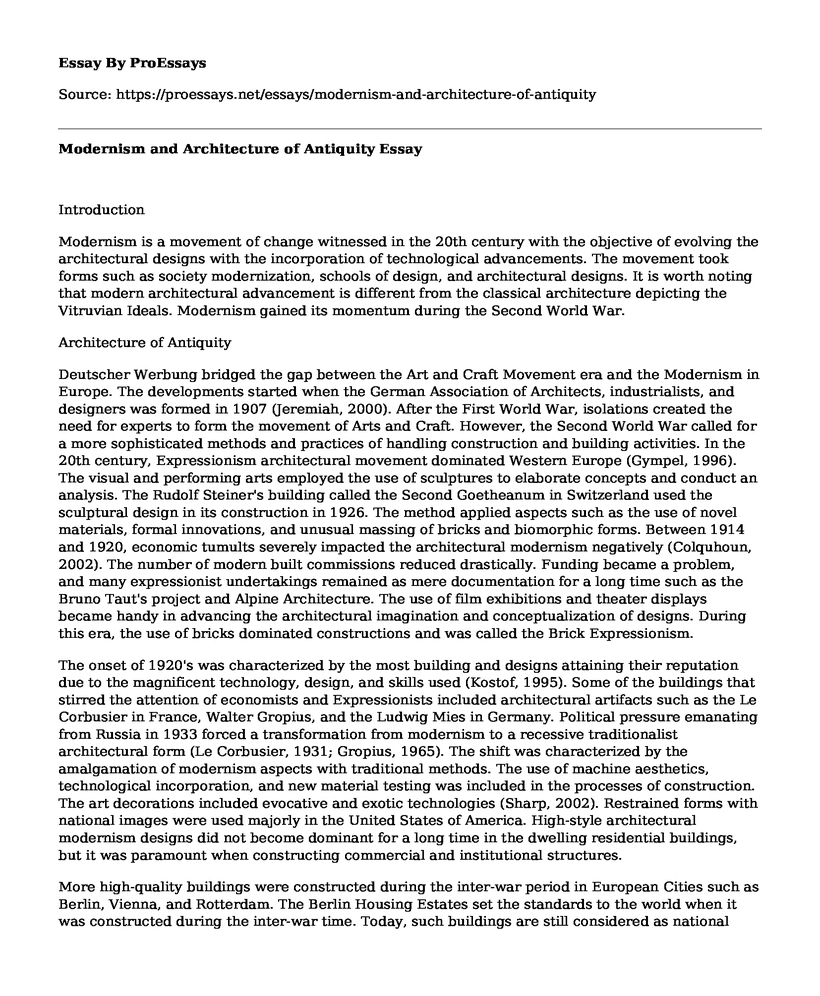Introduction
Modernism is a movement of change witnessed in the 20th century with the objective of evolving the architectural designs with the incorporation of technological advancements. The movement took forms such as society modernization, schools of design, and architectural designs. It is worth noting that modern architectural advancement is different from the classical architecture depicting the Vitruvian Ideals. Modernism gained its momentum during the Second World War.
Architecture of Antiquity
Deutscher Werbung bridged the gap between the Art and Craft Movement era and the Modernism in Europe. The developments started when the German Association of Architects, industrialists, and designers was formed in 1907 (Jeremiah, 2000). After the First World War, isolations created the need for experts to form the movement of Arts and Craft. However, the Second World War called for a more sophisticated methods and practices of handling construction and building activities. In the 20th century, Expressionism architectural movement dominated Western Europe (Gympel, 1996). The visual and performing arts employed the use of sculptures to elaborate concepts and conduct an analysis. The Rudolf Steiner's building called the Second Goetheanum in Switzerland used the sculptural design in its construction in 1926. The method applied aspects such as the use of novel materials, formal innovations, and unusual massing of bricks and biomorphic forms. Between 1914 and 1920, economic tumults severely impacted the architectural modernism negatively (Colquhoun, 2002). The number of modern built commissions reduced drastically. Funding became a problem, and many expressionist undertakings remained as mere documentation for a long time such as the Bruno Taut's project and Alpine Architecture. The use of film exhibitions and theater displays became handy in advancing the architectural imagination and conceptualization of designs. During this era, the use of bricks dominated constructions and was called the Brick Expressionism.
The onset of 1920's was characterized by the most building and designs attaining their reputation due to the magnificent technology, design, and skills used (Kostof, 1995). Some of the buildings that stirred the attention of economists and Expressionists included architectural artifacts such as the Le Corbusier in France, Walter Gropius, and the Ludwig Mies in Germany. Political pressure emanating from Russia in 1933 forced a transformation from modernism to a recessive traditionalist architectural form (Le Corbusier, 1931; Gropius, 1965). The shift was characterized by the amalgamation of modernism aspects with traditional methods. The use of machine aesthetics, technological incorporation, and new material testing was included in the processes of construction. The art decorations included evocative and exotic technologies (Sharp, 2002). Restrained forms with national images were used majorly in the United States of America. High-style architectural modernism designs did not become dominant for a long time in the dwelling residential buildings, but it was paramount when constructing commercial and institutional structures.
More high-quality buildings were constructed during the inter-war period in European Cities such as Berlin, Vienna, and Rotterdam. The Berlin Housing Estates set the standards to the world when it was constructed during the inter-war time. Today, such buildings are still considered as national archeological, political, and organizational achievements. However, the search for new models to advance achievements did not stop. In Berlin, state-initiated housing construction models resulted in the construction of the magnificent Greater Berlin. Conversely, not all modernism activities were successful. In the early 1970's, some of the architectural modernism structures were destroyed to pave the way for large-scale constructions because some depicted great failures (Henket, 2002). Applying the same principles of residential housing budgets was not successful. However, the desire to creating a better and advanced architectural analogy remained within any new design created by economists and architects.
Conclusion
Since the 19th century, the world started to feel the need to assimilate modern technology in building and construction practices and developed theories of design. By the 20th century, modernism in architectural development engulfed the expectations as the building became more sophisticated and magnificent. However, challenges were faced, and traditional methods had to be brought on board. The desire to have a more technology oriented architectural design continued to dominate construction.
References
Colquhoun, A. (2002). Modern architecture. Oxford: Oxford University Press.
Greenhalgh, P. (1990). Modernism in Design. London: Reaktion.
Gropius, W. (1965). The new architecture and the Bauhaus (Vol. 21). Cambridge, MA: MIT Press.
Gympel, J. (1996). The story of architecture: from antiquity to the present. New York: Konemann, 1996.
Henket, H. J. (2002). Modernity, Modernization, and Modern Movement. Rotterdam: 010 Publishers.
Jeremiah, D. (2000). Emergency, Economy, and Modernization. Manchester: Manchester University Press.
Jeremiah, D. (1999). Modernism in Design. Manchester: Manchester University Press.
Kostof, S. (1995). A history of architecture: settings and rituals. New York: Oxford University Press.
Le Corbusier. (1931). Towards a new architecture. North Chelmsford, MA: Courier Corporation.
Sharp, D. (2002). Twentieth Century Architecture: A Visual History Image. Melbourne: Publishing Group.
Cite this page
Modernism and Architecture of Antiquity. (2021, Mar 02). Retrieved from https://proessays.net/essays/modernism-and-architecture-of-antiquity
If you are the original author of this essay and no longer wish to have it published on the ProEssays website, please click below to request its removal:
- American History Book Curriculum
- A Literary Essay Example on Ceremony by Silko
- Essay Sample on The US Revolution: Political, Economic, Social, Cultural & Moral Factors
- Cinema Paradiso - Movie Analysis Essay
- Zara: U.K.-Based Fashion Co. Producing, Distributing Apparel & Accessories - Research Proposal
- Documentary Analysis Essay on Huey Long
- Essay Example on Neurotic Society: Anxiety, Mental Illness & Personality Impairment







